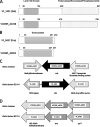Vibrio fischeri Possesses Xds and Dns Nucleases That Differentially Influence Phosphate Scavenging, Aggregation, Competence, and Symbiotic Colonization of Squid
- PMID: 36342139
- PMCID: PMC9680621
- DOI: 10.1128/aem.01635-22
Vibrio fischeri Possesses Xds and Dns Nucleases That Differentially Influence Phosphate Scavenging, Aggregation, Competence, and Symbiotic Colonization of Squid
Erratum in
-
Correction for Fidopiastis et al., "Vibrio fischeri Possesses Xds and Dns Nucleases That Differentially Influence Phosphate Scavenging, Aggregation, Competence, and Symbiotic Colonization of Squid".Appl Environ Microbiol. 2024 Jun 18;90(6):e0032724. doi: 10.1128/aem.00327-24. Epub 2024 May 7. Appl Environ Microbiol. 2024. PMID: 38712953 Free PMC article. No abstract available.
Corrected and republished in
-
Corrected and republished from: "Vibrio fischeri Possesses Xds and Dns Nucleases That Differentially Influence Phosphate Scavenging, Aggregation, Competence, and Symbiotic Colonization of Squid".Appl Environ Microbiol. 2024 Jun 18;90(6):e0032824. doi: 10.1128/aem.00328-24. Epub 2024 May 7. Appl Environ Microbiol. 2024. PMID: 38712952 Free PMC article.
Abstract
Cells of Vibrio fischeri colonize the light organ of Euprymna scolopes, providing the squid bioluminescence in exchange for nutrients and protection. The bacteria encounter DNA-rich mucus throughout their transition to a symbiotic lifestyle, leading us to hypothesize a role for nuclease activity in the colonization process. In support of this, we detected abundant extracellular nuclease activity in growing cells of V. fischeri. To discover the gene(s) responsible for this activity, we screened a V. fischeri transposon mutant library for nuclease-deficient strains. Interestingly, only one strain, whose transposon insertion mapped to nuclease gene VF_1451, showed complete loss of nuclease activity in our screens. A database search revealed that VF_1451 is homologous to the nuclease-encoding gene xds in Vibrio cholerae. However, V. fischeri strains lacking xds eventually revealed slight nuclease activity on plates after 72 h. This led us to hypothesize that a second secreted nuclease, identified through a database search as VF_0437, a homolog of V. cholerae dns, might be responsible for the residual nuclease activity. Here, we show that Xds and/or Dns are involved in essential aspects of V. fischeri biology, including natural transformation, aggregation, and phosphate scavenging. Furthermore, strains lacking either nuclease were outcompeted by the wild type for squid colonization. Understanding the specific role of nuclease activity in the squid colonization process represents an intriguing area of future research. IMPORTANCE From soil and water to host-associated secretions such as mucus, environments that bacteria inhabit are awash in DNA. Extracellular DNA (eDNA) is a nutritious resource that microbes dedicate significant energy to exploit. Calcium binds eDNA to promote cell-cell aggregation and horizontal gene transfer. eDNA hydrolysis impacts construction of and dispersal from biofilms. Strategies in which pathogens use nucleases to avoid phagocytosis or disseminate by degrading host secretions are well documented; significantly less is known about nucleases in mutualistic associations. This study describes the role of nucleases in the mutualism between V. fischeri and its squid host, Euprymna scolopes. We find that nuclease activity is an important determinant of colonization in V. fischeri, broadening our understanding of how microbes establish and maintain beneficial associations.
Keywords: Euprymna scolopes; Vibrio fischeri; biofilm; genetic competence; nuclease; symbiosis.
Conflict of interest statement
The authors declare no conflict of interest.
Figures










References
-
- Livia L, Antonella P, Hovirag L, Mauro N, Panara F. 2006. A nondestructive, rapid, reliable and inexpensive method to sample, store and extract high-quality DNA from fish body mucus and buccal cells. Mol Ecol Notes 6:257–260. 10.1111/j.1471-8286.2005.01142.x. - DOI
Publication types
MeSH terms
Substances
Grants and funding
LinkOut - more resources
Full Text Sources

